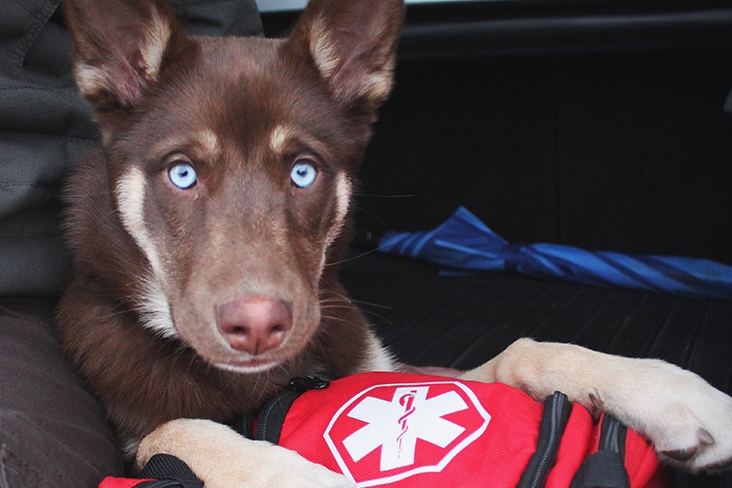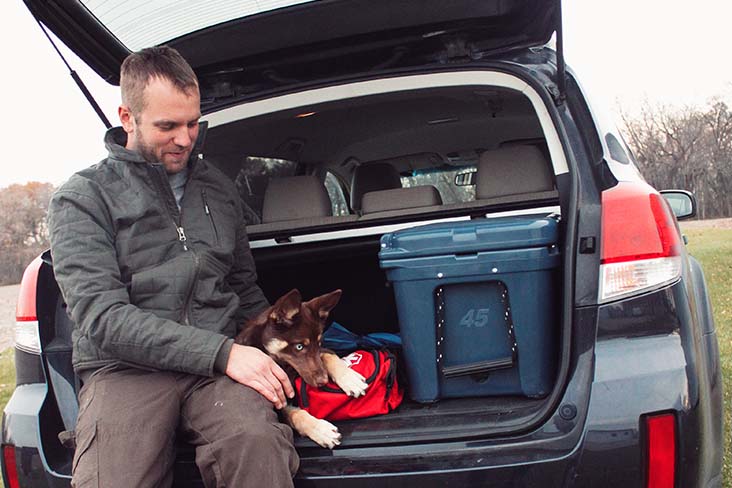Family trips are not complete without my dog, Annie, a dachshund mix I rescued from the streets of Baja, Mexico. Annie loves nothing more than burrowing herself into the bottom of the double sleeping bag I share with my partner on camping trips.
But, just like people, dogs can get injured outdoors. It’s prudent to keep a few supplies in your vehicle, especially if you’re a long way from a higher level of care.
Here are the items I carry in a little box behind my front seat so that I’m prepared for anything from a morning hike to a week-long overland adventure. I also spoke with Dr. Karen Fine, a veterinarian at Central Animal Hospital in Leominster, Massachusetts, about safety precautions to consider. However, before giving your dog any medication he or she hasn’t had before, it’s best to consult with a vet who can advise based on your pet’s specific health history.
Tweezers and a Magnifying Glass
A pair of point-tip tweezers and a magnifying glass (or strong over-the-counter magnifying glasses, which leave both hands free) are handy for dog and owner alike. You can remove splinters, ticks, foxtails and cactus spines that you might encounter along the trail.
Styptic Powder
“One of the things I see a lot is dogs hiking out in the woods, and they either cut their paw on something sharp or they tear off a nail,” Fine says. Styptic powder is an antiseptic clotting agent that helps to prevent infection and stop bleeding.

Vetrap Self-Adhesive Bandage Roll
Vetrap™ bandaging tape has many uses. If you combine it with nonsticking gauze or cotton pads, you can treat a wound (once you clean it out) and help control bleeding while you get to a higher level of care.
A Soft Muzzle
A proper muzzle is not expensive or bulky and well worth carrying. If you have a bigger dog, it can really help in keeping them from hurting you or a stranger when they’re injured and afraid. Remember, though, that these may stop your dog from panting, which they need to do to cool down, so use only for short periods and make sure the muzzle is the right size and fit (your vet can advise on this).
Benadryl Tablets
My dog likes to eat bees, to which she is allergic. Her whole face blows up. To treat this and other allergies to plants and insects, I use Benadryl®. For pets, avoid Benadryl preparations with xylitol, Fine cautions. In general, before using any human medication on your dog, talk to your vet to make sure it’s the right choice and dosage for your dogʼs size and breed.
An Oral Syringe
A small, inexpensive oral syringe can help you get liquid medication down your dog’s throat.
Pill Pockets
If your pup doesn’t do well with tablet medication, bring some Pill Pockets™ to make meds easier to swallow.

A Blanket
If your dog needs a vet, you want to focus on keeping them comfortable and happy while you get them to a higher level of care.
Annie can deal with anything as long as she has a blanket to hide under, so I bring along this supersoft Snow Peak Flexible Insulated Blanket. Blankets can also be good to sling under the belly of a big dog with weak or injured hind legs; you support them with the blanket and “wheelbarrow” them as they walk on their front legs.
Any Meds Your Dog Takes Regularly
Be conscious of proper storage and expiration for any medication. If you’re not sure how to store them or when they expire, check the packaging they came in or ask your vet.





